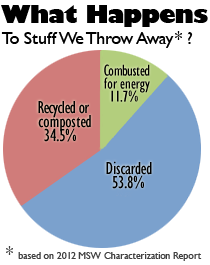Learn

Solid Waste
Solid waste is any garbage, refuse, or sludge that results from industrial, commercial, mining or agricultural operations and any community or residential activities. According to the EPA website, Americans produced 251 million tons of solid waste in 2012. Solid waste consists of metals, paper/cardboard, glass, plastics, wood, yard trimmings, food waste, and textiles.
Solid waste can be divided into two types of waste products:
- biodegradable
- non-biodegradable
Biodegradable wastes can be broken down naturally through the process of decomposition. Yard trimmings, food wastes, wood and paper/cardboard are all examples of biodegradable materials. They are all organic and come from once living sources. Although biodegradable wastes do break down over time, it can often take many years for them to completely decompose.
Non-biodegradable wastes are items or products that cannot be broken down by the natural process of decomposition. Glass, plastics, and metals are examples of non-biodegradable wastes products.

It may not seem like much at the time, but it all adds up to a critical mass of solid waste.

Landfills
Much of the solid waste that humans produce is sent to landfills where it is dumped, compacted, and buried under layers of dirt. Landfills are not aesthetically something pleasing to the senses pleasing to the eye or nose. Landfills take up land space and can contribute to pollution. Landfills contribute to air pollution because of dangerous gases that are emitted from the decomposition of biodegradable material. Methane is the primary gas of more than 10 gases that are produced during decomposition. The gases move up through the layers of soil and migrate to areas outside of the landfill. These gases can be harmful to humans.
Landfills are also a major source of ground water pollution. A harmful liquid known as leachate forms in landfills. Leachate mixes with rain water, leaches out of the landfill, and enters underground and surface water supplies. Most landfills are lined with a protective barrier to help prevent leachate from contaminating water supplies. However these barriers are often compromised over time allowing the leachate to infiltrate into the ground water supply.
![]() Watch Waste Deep (5:26) from PBS Learning Media to learn more about landfills.
Watch Waste Deep (5:26) from PBS Learning Media to learn more about landfills.
Because even biodegradable wastes take long periods of time to completely break down, landfills are quickly filling up. According to the EPA, 18,500 landfills were available to receive trash in the United States. In 1988, there were only 7,924 landfills available and in 2006 only 1,754 landfills were available in the United States.

Reducing Waste
Because of the environmental issues, aesthetic problems, and declining room in landfills, new methods need to be introduced to substantially decrease the amount of solid waste that is being disposed of in landfills. Landfill waste can be reduced through
- reusing,
- recycling, and
- composting waste materials.
The best way to reduce waste is by not creating waste. This can be accomplished by reusing materials. The production of new products requires a lot of energy and materials that will eventually become waste.
Another way of managing solid waste is through recycling. Recycling involves the collection and processing of materials into new products. By doing this, the amount of waste that is sent to landfills is reduced. Metals, paper/cardboard, plastics, and glass are products that are often recycled. Read Recycling Facts from Recycle Across America to learn more about the different types of materials you can recycle.

Three things to live by when it comes to reducing waste.
A third way to reduce the amount of solid waste going to the landfill is through composting. Composting involves taking food wastes and yard trimmings and storing them in a place where they can decompose naturally. The materials that results from composting is called compost. Compost can be used in gardens, flower and shrub beds, and lawns as a natural fertilizer. This type of fertilizer can be used in the place of synthetic fertilizers. Read Composting at home from the EPA's website to learn about the benefits of composting and the five primary variables that must be controlled and maintained during composting. You may also want to visit Types of Composting to learn about the five types of composting.

Composting–A good way to recycle left overs.
Check out The Do's and Don'ts of Composting.
According to the EPA, 87 million tons of the 251 million tons of solid waste produced in 2012 was recycled or composted, which is equivalent to a 34.5% recycling rate.

 |
 |